What Is B2B Digital Marketing? (A Beginner’s Guide)

Before we jump to any discussion – Do you know? Digital advertising expenditures for businesses-to-business (B2B) grew significantly in 2021, increasing by 22%. Despite this rise in spending, overall digital ad spending reached only $8.62 billion in 2021.
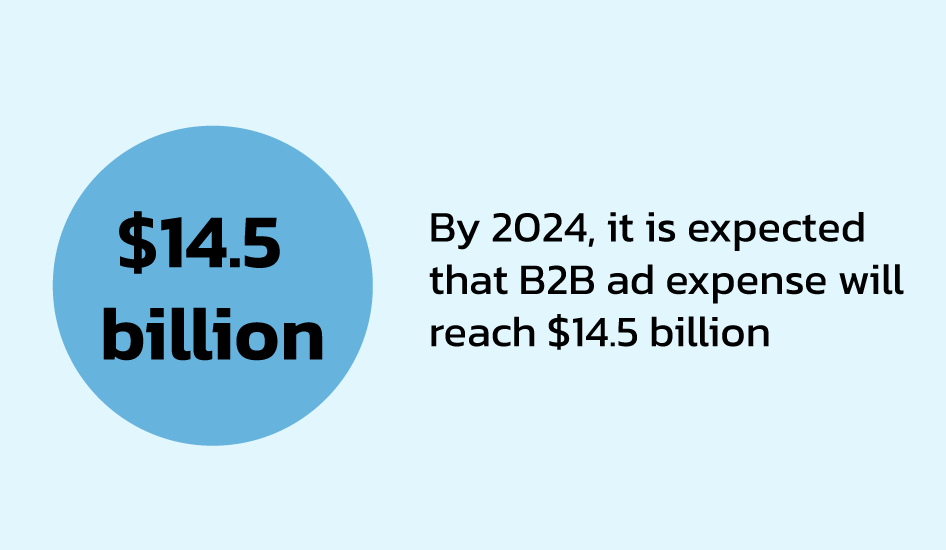
However, projections suggest that B2B digital ad expenses will continue to increase, reaching an estimated total of $14.5 billion in 2024. This anticipated growth represents a strong recovery from the dip experienced in 2020 when spending dropped to $5.56 billion.
Business-to-business (B2B) organisations specialise in selling goods and services to other businesses. Like most others, these companies utilise marketing tactics to reach their target audience and promote their offerings. In this comprehensive introduction to B2B digital marketing, we will explore the definition and nuances of B2B marketing, compare it with business-to-consumer (B2C) marketing, and provide practical tips and strategies for effective B2B campaigns.
Whether you represent a B2B organisation or want to understand the industry better, this guide is designed to give you a solid foundation in B2B digital marketing.
What is B2B Digital Marketing?
B2B digital marketing encompasses various aspects of traditional digital marketing methods such as search engine optimization (SEO), pay-per-click (PPC) management, email marketing, and content marketing, explicitly tailored towards business-to-business (B2B) communication. At the same time, individual consumers are the primary focus of business-to-consumer (B2C) marketing, B2B marketing centres around engaging other organisations and corporate entities.
The goal of B2B digital marketing is frequently centred around generating leads, where prospective clients get in touch with your firm through a web form on your site or express interest in a product demo or free trial if you offer tech or software solutions.
Because the procurement cycle for B2B enterprises is generally more protracted and involves larger monetary values than B2C transactions, B2B digital marketing methodologies require greater deliberation and planning to cater to an extended buyer journey.
High-quality content creation is critical to any successful B2B digital marketing strategy. Understanding your target audience and their difficulties is crucial when devising an efficient B2B marketing plan. Consequently, many procedures commence by identifying distinct buyer personas and their associated pain points, allowing marketers to create personalised content that addresses those issues and captures the attention of potential clients.
By cultivating a thorough knowledge of your target market and implementing carefully crafted B2B digital marketing techniques, you can increase the likelihood of achieving success in this domain.
What Are the Core Pillars of B2B Digital Marketing
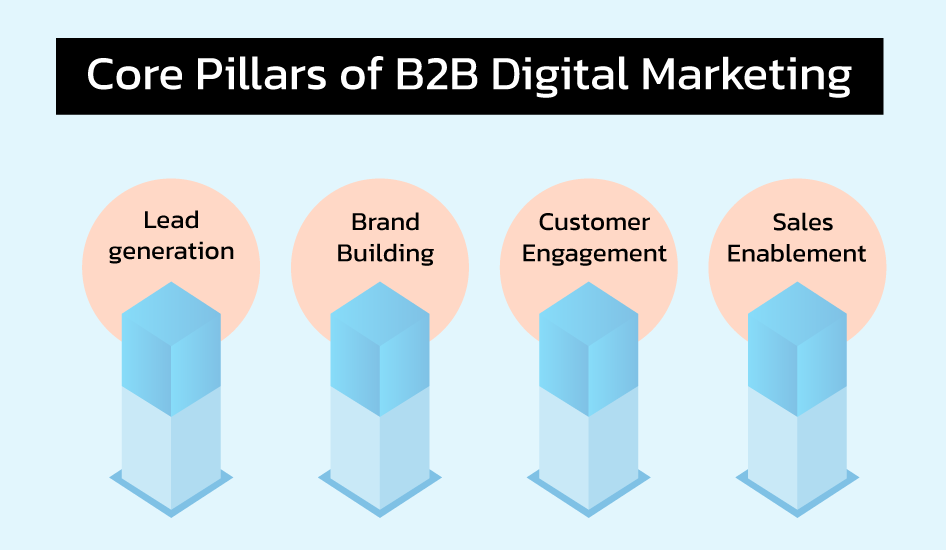
The core pillars of B2B digital marketing refer to the fundamental concepts that drive effective marketing strategies for businesses seeking to connect with other organisations.
These pillars serve as guiding principles for developing comprehensive plans to foster meaningful interactions with target audiences and ultimately lead to fruitful partnerships.
Here’s a closer look at each of these essential components:
1. Lead generation
Lead generation at its heart, B2B digital marketing revolves around generating qualified leads for your business. Leads are potential customers who have shown interest in your products/services, making them valuable prospects for future sales opportunities.
Your marketing efforts should focus on creating content that appeals to your target audience and encouraging them to take action, whether filling out a contact form or requesting a quote.
2. Brand Building
A strong brand identity is vital for standing out from competitors and establishing credibility with your target market. Your B2B digital marketing plan should incorporate initiatives that help reinforce your unique value proposition and differentiate your brand.
This may involve developing a recognisable logo, designing a user-friendly website, producing compelling video content, and maintaining an active presence across social media platforms.
3. Sales Enablement
B2B digital marketing also entails equipping your sales team with the tools necessary to effectively communicate the benefits of your products/services to potential clients.
By arming your sales force with relevant data, customer insights, and powerful messaging, you enhance their capacity to engage with prospects and close deals more efficiently.
Utilising sales enablement resources like customised presentations, training materials, and collaborative technologies can significantly boost your chances of converting leads into loyal customers.
4. Customer Engagement
Finally, embracing a culture of continuous improvement is critical to ensuring the ongoing effectiveness of your B2B digital marketing approach. Keep track of performance metrics, analyse customer feedback, and regularly update your strategies accordingly.
Stay abreast of your industry’s emerging trends, new technologies, and best practices to remain agile and adaptive in today’s fast-paced digital landscape. Embrace experimentation and risk-taking to uncover innovative approaches that set your brand apart and solidify your position as a trusted partner to your B2B clientele.
B2B Customer Life Cycle – Fully Explained
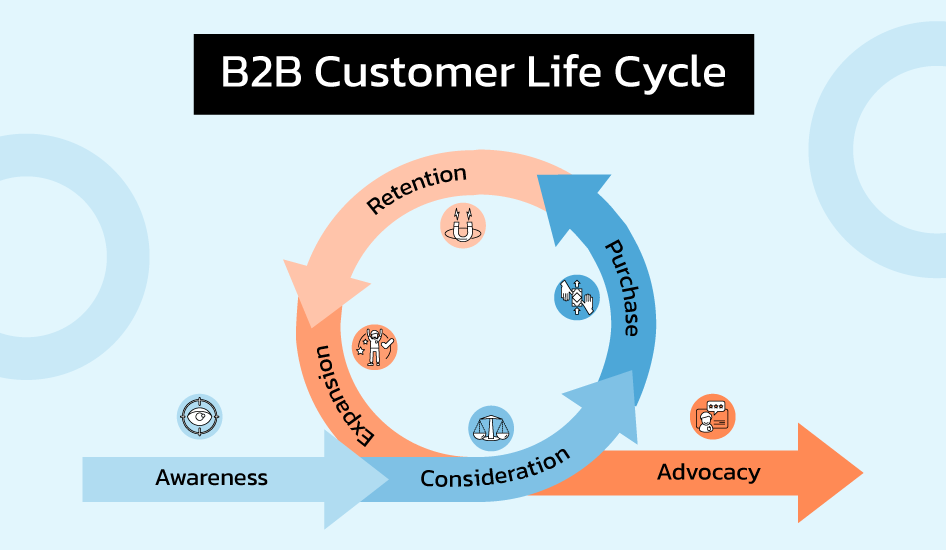
In a B2B setting, the customer lifecycle consists of six distinct stages that outline the progression of a relationship between a company and its clients.
Each stage requires careful consideration and tailored marketing efforts to maximise the potential for growth and retention over time.
Below we delve deeper into each phase of the B2B customer lifecycle:
1. Awareness
Initially, prospective buyers become aware of your organisation and its offerings. During this stage, your marketing campaigns should focus on building brand visibility and educating the market about your capabilities.
Utilise search engine optimization, content marketing, and social media advertising to reach your target audience and generate interest in what you do.
2. Consideration
Once individuals recognise your brand and grasp what you provide, they enter the consideration stage.
At this juncture, potential customers evaluate whether your solutions align with their needs and requirements.
Focus on providing educational resources, case studies, and product demonstrations to aid decision-makers in evaluating.
3. Purchase
When a business decides to invest in your products or services, the transaction occurs, signalling the start of the post-purchase experience. Ensure the purchasing process is seamless, providing clear instructions, transparent pricing, and multiple payment options to minimise friction during checkout.
Additionally, offering excellent customer support throughout this initial interaction helps solidify positive sentiments toward your brand.
4. Retention
After the first sale, the objective shifts to nurturing an ongoing relationship with your newly acquired customer. Provide exceptional service, consistent communication, and timely follow-ups to demonstrate your commitment to their satisfaction.
Offer incentives for repeat purchases, such as discounts or loyalty programs, to encourage continued engagement with your organisation.
5. Expansion
As the bond between your organisation and an existing customer strengthens, an opportunity arises to expand your collaboration’s scope. Encourage upselling by showcasing complementary products or services that could further address their evolving needs. Cross-selling related offerings would be beneficial, given their current usage patterns.
Strategic account management plays a crucial role here, involving dedicated representatives who work closely with customers to identify areas ripe for growth and develop personalised solutions tailored to their specific circumstances.
By actively pursuing expansion opportunities, you can increase both revenue and customer lifetime value while deepening your connection with valued clients.
6. Advocacy
Ultimately, satisfied customers become vocal advocates for your brand, powerful allies in spreading awareness and driving new business. By consistently delivering high-quality experiences, you foster a sense of loyalty among clients who are more likely to refer others to your organisation.
Leverage testimonials, case studies, and word-of-mouth endorsements to amplify your message and attract fresh prospects eager to explore the advantages of working with you.
By cultivating a robust network of advocates, you create a self-perpetuating cycle of growth fuelled by satisfied customers eager to share their positive experiences with peers and colleagues within their respective industries.
Differences between B2B and B2C Marketing

Although B2B (Business-to-Business) and B2C (Business-to-Consumer) marketing aim to promote goods and services, several critical differences exist between these two approaches.
Understanding the distinctions allows companies to craft more effective marketing strategies tailored to their target audiences.
Here’s an exploration of some fundamental dissimilarities between B2B and B2C marketing:
1. Target Market
The primary distinction between B2B and B2C marketing is the intended audience. While B2B organisations sell products or services directly to other businesses, B2C firms cater to individual consumers.
Consequently, B2B marketers must comprehend the unique needs and challenges different types of businesses face, whereas B2C marketers often focus on broader consumer trends and preferences.
2.Buying Process
B2B sales typically involve longer and more complex buying processes than B2C transactions. Multiple stakeholders may be interested in the decision-making process, including executives, department managers, and procurement specialists.
Therefore, B2B marketers must convey how their offerings solve specific problems, improve efficiency, or reduce costs within a broader organisational framework. In contrast, B2C marketing often involves emotional appeals, emphasising product features and benefits that resonate with individual consumers.
3. Communication Channels
B2B and B2C marketing employ varying channels to connect with their target audiences. For instance, LinkedIn remains a popular platform for B2B professionals seeking to build networks, share insights, and promote their expertise.
On the other hand, Facebook, Instagram, and Twitter serve as vital platforms for B2C brands looking to engage with consumers through visual storytelling, influencer partnerships, and user-generated content.
4. Sales Cycle
Given the complexity of B2B buying processes, longer sales cycles are typical. Building relationships and trust with potential clients take precedence over quick closes. This involves multiple interactions, frequent communication, and a deep understanding of customer needs.
Throughout the process, B2B sales reps function as consultants rather than traditional salespeople, offering tailored solutions and value propositions to address specific challenges. During this phase, strong industry knowledge, solution presentation, and negotiation skills remain crucial.
As the sale progresses, B2B reps continually assess customer feedback, adjusting their approach to maximise the chances of securing the deal. Post-sale follow-up is equally important, ensuring customer satisfaction and identifying opportunities for cross-selling or upselling.
5. Technical Support and Customer Service
Regarding post-purchase support, B2B sellers often provide comprehensive technical assistance and dedicated account managers to help clients integrate new products into their existing systems. B2C firms usually have customer service representatives to handle product inquiries, returns, or complaints. The level of support required can vary greatly depending on the type of product or service offered, with B2B customers expecting more advanced guidance due to the specialised nature of their purchases.
6. Brand Loyalty
Lastly, brand loyalty plays a different role in B2B versus B2C marketing. While B2C customers may develop emotional attachments to brands they favour, B2B buyers prioritise long-term partnerships based on trustworthiness, dependability, and consistent quality. Brand recognition and credibility are crucial for B2B businesses looking to build enduring client relationships.
In conclusion, although B2B and B2C marketing share some basic principles, several distinguishing characteristics set them apart.
By recognising these dissimilarities and tailoring their strategies accordingly, businesses can better cater to the unique needs of their respective target audiences and achieve long-term success in their respective markets.
Why Do You Need B2B Marketing?
As the marketing landscape becomes progressively crowded and competitive, standing out has become arduous. Each year, the clamour intensifies, making it challenging for organisations to connect with their intended audiences without breaking the bank.
Traditional advertising methods, such as email blasts and cold calling, have lost much effectiveness in recent years. This decline in efficiency is partly attributed to the escalating costs associated with these approaches. For instance, data from the past five years indicates a staggering 312% increase in the price of Google Ads. Given this trend, marketing expenses will likely persist at elevated levels.
Moreover, the evolving habits of potential customers further complicate matters. Today’s buyers are far more informed and self-sufficient than ever, relying heavily on digital resources to inform their purchasing decisions.
According to Blue Corona, nearly two-thirds of B2B buyers can now make purchase commitments exclusively based on digital content. Consequently, marketing professionals must adapt to these changes by adopting innovative tactics that resonate with contemporary buyers.
The prolonged decision-making process is another consequence of the widening pool of online information. Nowadays, over half of all buyers take significantly longer to arrive at a verdict because they gather inputs from multiple sources.
Furthermore, the inclusion of additional team members in the purchasing process has grown markedly. These findings emphasise the growing importance of providing comprehensive and relevant material to guide prospective buyers throughout their deliberation stages.
Ultimately, grasping these shifts in consumer behaviour and devising appropriate strategies remains critical for successful B2B and B2C marketing initiatives.
The purpose of B2B marketing is clear:

To stand out amidst the cacophony and effectively reach one’s target audience. Achieving success in B2B marketing entails increasing brand visibility, captivating the attention of potential clients, and ultimately driving conversions and boosting return on investment (ROI) while minimising costs.
These objectives underscore the significance of having a robust B2B marketing division within an organisation. However, realising these goals requires a thorough understanding of developing and implementing an effective B2B marketing strategy.
In the following sections, we will explore two distinct marketing methodologies to help elucidate the intricacies of B2B marketing. Companies can formulate more impactful and results-driven campaigns by gaining insight into these strategies.
How Do You Digitally Promote Your B2B Company?
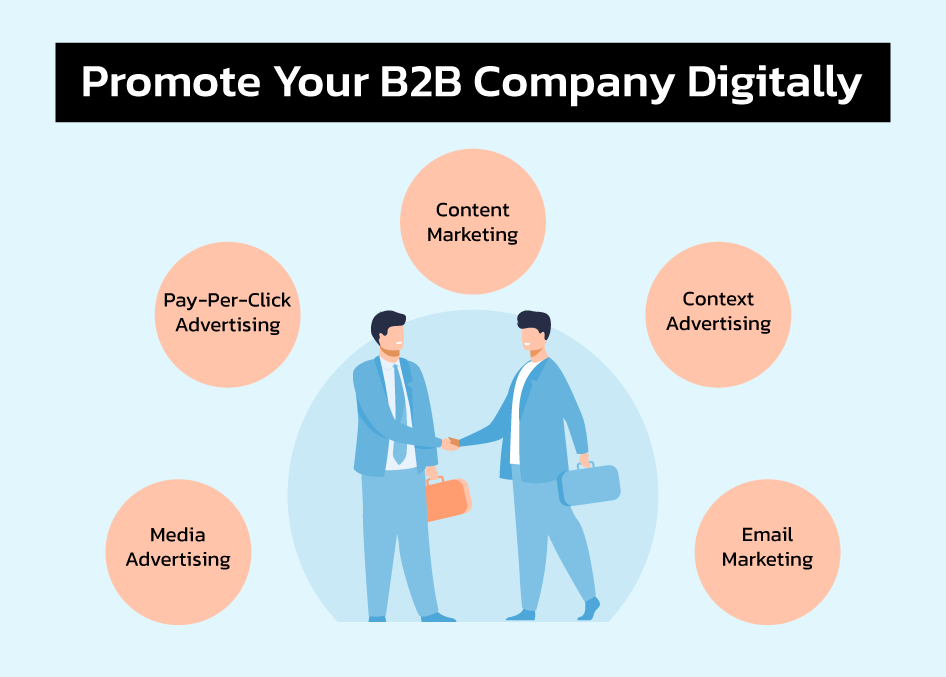
The world has embraced digitisation, and businesses must stay caught up. An online presence is vital to remain competitive and engage with potential clients.
Fortunately, numerous B2B marketing strategies exist to enhance your firm’s exposure and attract new leads. Leveraging LinkedIn is a potent option among these techniques due to its extensive professional network.
Many B2B organisations have successfully generated leads and strengthened their brands by capitalising on this platform. Thus, exploring LinkedIn may prove advantageous if you’re seeking to expand your client base or bolster your company’s image.
Content Marketing
Creating valuable content such as tutorials, guidelines, and shareable materials demonstrates your firm’s proficiency and credibility. While some view self-promotion as unseemly, social media platforms like LinkedIn allow businesses to showcase their capabilities and connect with potential customers.
By incorporating engaging narratives into your content, you can tap into your audience’s emotional responses and encourage them to convert into loyal patrons. Mastering the art of digital storytelling is a crucial skill for any enterprise looking to build meaningful relationships with its clientele and achieve tangible results.
Email Marketing
Similar to making cold calls, email marketing is a powerful approach to contact possible customers by sending informative messages. This tactic involves sharing details regarding your offerings to obtain a response or request for further information.
Additionally, firms often employ email marketing to update current clients on recently launched products or services. By harnessing the power of personalised communication via email, companies can foster stronger relationships with their customer bases and cultivate a loyal following.
Context Advertising
Being bombarded with irrelevant promotional material can be frustrating and off-putting for individuals. Even if someone stumbles upon an advertisement related to your products or services, if they do not belong to your intended audience, they are unlikely to be genuinely engaged or receptive to the message.
Contextual advertising can significantly improve the effectiveness of your marketing efforts. By displaying sponsored content exclusively to people with shared interests, you increase the likelihood of reaching and resonating with prospective clients, enhancing conversion chances and ultimately boosting your ROI.
Media Advertising
Utilising visually appealing content is undoubtedly an effective method for capturing the interest of your audience. However, it is essential to ensure that the execution is flawless to maximise impact and efficiently convey your message.
One potent strategy is creating videos that encapsulate valuable insights or data that could persuade potential customers to take action. By presenting this information in a dynamic and engaging format, you increase the probability of grabbing users’ attention and standing out among other posts that may rely solely on text.
On LinkedIn specifically, videos garner greater visibility than plain text-based updates, leading to increased visibility and higher chances of converting leads into paying customers.
Pay-Per-Click Advertising (PPC)
Pay-per-click advertising (PPC) is an effective digital marketing strategy for B2B businesses looking to boost their online presence and generate quality leads. PPC involves placing online ads on search engines like Google, Bing, and Yahoo!, as well as social media platforms like Facebook and LinkedIn.
These ads are designed to appear at the top of search engine results pages (SERPS) when people search for specific keywords related to your products or services.
With PPC, you only pay when someone clicks on your ad, hence the name “pay-per-click.” This means you can control your budget and ensure that your ads reach the right audience at the right time.
Additionally, because PPC ads are targeted to specific keywords, they tend to attract higher-quality leads already interested in your offerings.
When setting up a PPC campaign, you must identify the keywords you want to target, create compelling ad copy that encourages people to click on your ad and design a landing page where visitors can take further action, such as filling out a form or purchasing.
You will also need to set a bid amount for each keyword, determining how often your ad appears and its position on the SERP.
Overall, PPC is a powerful B2B digital marketing strategy that can help you achieve your business goals quickly and efficiently. With careful planning and management, you can use PPC to drive traffic to your website, generate qualified leads, and grow your business.
Lead Generation
Lead generation is crucial to any successful B2B digital marketing strategy. It refers to identifying and capturing potential customers who have expressed an interest in your product or service.
Effective lead generation helps B2B businesses expand their customer base, increase revenue, and improve long-term growth.
There are several ways to generate leads digitally, including:
Website Lead Capture Forms
Creating optimized lead capture forms on your website is one of the most effective lead generation techniques. The documents should be simple, user-friendly, and require minimal information from the prospective customer. For instance, asking for just their name and email address is usually enough to start building a relationship.
Gated Content Offers
Another potent lead generation tactic is developing valuable content assets such as eBooks, whitepapers, case studies, and webinars, requiring users to provide contact details in exchange for access. The content should focus on solving problems your target audience faces and giving value.
Targeted Ad Campaigns
Running targeted advertisements on search engines, social media platforms, and other websites can help you reach a broader audience and generate more leads. Utilise specific targeting options, such as demographics, location, interests, and behaviours, to showcase your ads to people likely interested in your offer.
Referral Programs
Encouraging existing customers to refer new clients to your business can significantly boost your lead-generation efforts. Offer incentives, such as discounts, freebies, or loyalty points, to reward customers who bring in new leads.
Events and Webinars
Organising events, conferences, and webinars centred around topics relevant to your industry can help you attract potential customers and gather their contact information. Promote these events extensively across multiple channels to maximise attendance.
Don’t Forget to Follow the below tips:
Follow the 80/20 rule.
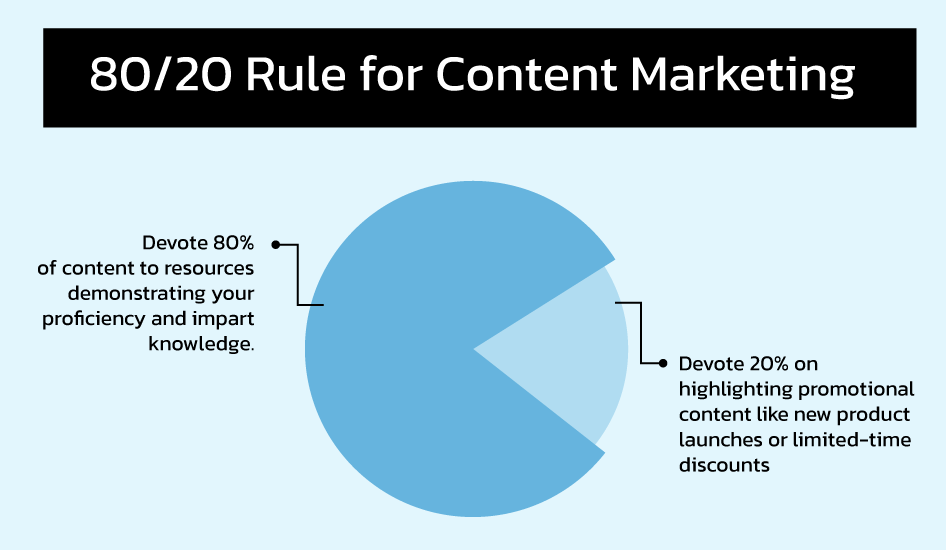
Data suggests that nearly all B2B marketers incorporate content marketing into their strategies. However, determining what type of material to post on LinkedIn can be puzzling. To optimize results, adhere to the 80/20 rule: devote 80% of your content to valuable resources demonstrating your proficiency and impart knowledge, such as instructional videos, informative articles, industry news updates, and e-books.
The remaining 20% should highlight promotional content like new product launches or limited-time discounts. By heeding this guideline, you foster trustworthiness within your network while still promoting your products or services.
To further refine your lead generation approach, recognise additional methods beyond simply utilising the site’s search functionality. Users may encounter your company through either traditional conversions or micro-conversions.
Traditional conversions occur when a potential customer responds positively to your call-to-action and receives follow-up communication from a sales representative.
Micro-conversions transpire when individuals exhibit interest in your organisation by, for example, subscribing to your company page or sharing your content.
Upon establishing effective lead collection processes, concentrate on motivating converts to act.
Incentivise them with exclusive offers, interact with their content, or schedule face-to-face interactions. The appropriate course of action hinges on your enterprise, but the process remains straightforward.
Emphasis On Finding Your Targets
Devoid of a comprehensive grasp of your target market, devising an efficient marketing plan becomes immensely challenging. Thus, investing substantial effort into conducting thorough research to identify and define your desired demographic is indispensable.
During your initial ideation process, dedicate ample time to delving into these details and constructing detailed profiles known as buyer personas. These fictitious representations serve as a foundation to guide all future content creation, ensuring every piece published remains focused on catering to your particular audience.
Your content must speak directly to your audience’s unique needs, interests, and preferences to effectively pique their interest and inspire action. For instance, pitching a product to a teenager versus an elderly individual requires distinct approaches and tailoring your messaging accordingly.
Adopting a nuanced strategy that accommodates these disparities bolsters your odds of successfully connecting with and swaying your ideal consumers.
7 B2B Digital Marketing Tips & Tricks You Should Know in 2023
Digital marketing plays a significant role in B2B industries, with various technological advancements helping businesses to streamline their processes and reach their target audiences effectively.
However, while leveraging these tools is essential, staying focused on them is equally crucial. Instead, use technology to enhance the overall user experience, boost efficiency, and support your business objectives.
Doing so unlocks vast growth and success opportunities within the competitive B2B landscape.
To stay ahead of the curve and capitalise on the latest developments, consider taking digital marketing courses that delve into current trends and best practices. These resources can empower you to harness emerging technologies and remain agile in response to evolving consumer preferences.
However, even as you embrace innovation, always remember that people ultimately desire human interactions. Remember that behind every online interaction is a natural person with unique needs, preferences, and expectations.
Therefore, prioritise fostering genuine connections with your target audience through personalisation and relevant messaging tailored to their journeys.
As you craft your B2B digital marketing strategy, keep these seven fundamental principles in mind:
- Create Valuable Content: Produce engaging, informative, and shareable content that resonates with your target audience. Focus on delivering solutions to their pain points and offering insights that educate and inspire.
- Personalise Your Marketing: Customise your communications based on audience segments, geographical locations, and individual behaviour patterns. Use data analytics tools to gain insights into your customers’ preferences and tailor your approach accordingly.
- Cater to Each Stage of the Buyer Journey: Understand the different phases your prospects pass through before converting into customers. Design content that caters to their specific needs during each stage, whether awareness, consideration, or decision.
- Deliver Consistency Across Digital Marketing Channels: Ensure your brand message remains consistent across all touchpoints where your audience interacts with your company. From website design to social media profiles, maintain a coherent visual identity and voice to build consumer trust and recognition.
- Think from a Prospect Perspective: Place yourself in your audience’s shoes and understand their motivations, challenges, and goals. Align your messaging and content with their interests and pain points to establish strong emotional connections and encourage long-term customer loyalty.
- Collect and Analyse Data: Gather information about your audience’s behaviour, preferences, and engagement levels. Leverage this data to refine your marketing approach, measure performance, and adapt to changing circumstances. Tools like Google Analytics can help you track metrics, monitor conversions, and optimize your campaigns.
- Stay Informed About Upcoming Trends: Keep an eye on the ever-evolving digital marketing landscape by participating in industry discussions, attending webinars and workshops, and reading industry publications. Anticipating future trends will enable you to stay ahead of the competition and continuously enhance your marketing initiatives.
Wrap Up
Many companies succeed by mastering the art of nurturing potential customers throughout their journey with the organisation.
This involves drawing traffic to the site, capturing lead information, guiding prospects towards conversion, ensuring customer retention, and eventually transforming satisfied clients into vocal advocates for the brand.
While implementing such a comprehensive system may require a substantial investment of time and effort upfront, the long-term benefits often greatly exceed the costs. If you want to develop your effective B2B Digital Marketing Strategy, please get in touch with us at +919054331400 or hello@nflowtech.com.







